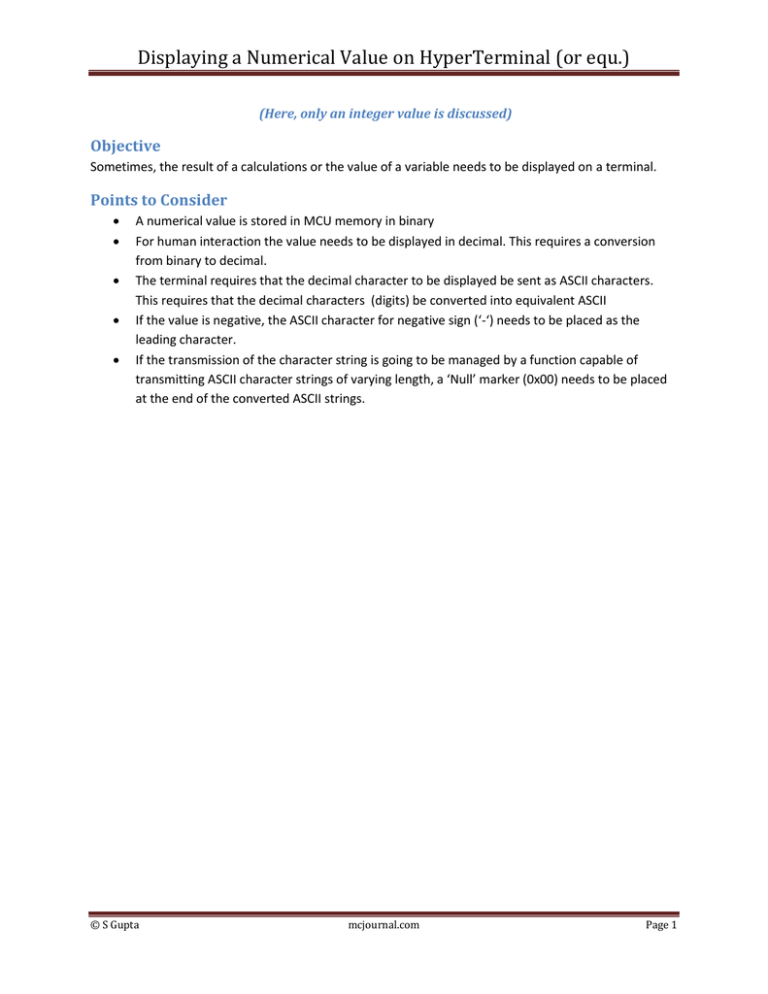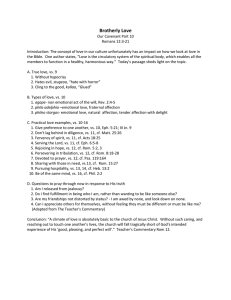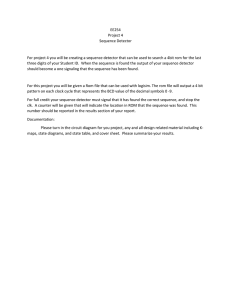Displaying a Numerical Value on HyperTerminal (or equ.)
advertisement

Displaying a Numerical Value on HyperTerminal (or equ.)
(Here, only an integer value is discussed)
Objective
Sometimes, the result of a calculations or the value of a variable needs to be displayed on a terminal.
Points to Consider
A numerical value is stored in MCU memory in binary
For human interaction the value needs to be displayed in decimal. This requires a conversion
from binary to decimal.
The terminal requires that the decimal character to be displayed be sent as ASCII characters.
This requires that the decimal characters (digits) be converted into equivalent ASCII
If the value is negative, the ASCII character for negative sign (‘-‘) needs to be placed as the
leading character.
If the transmission of the character string is going to be managed by a function capable of
transmitting ASCII character strings of varying length, a ‘Null’ marker (0x00) needs to be placed
at the end of the converted ASCII strings.
© S Gupta
mcjournal.com
Page 1
Displaying a Numerical Value on HyperTerminal (or equ.)
Conversion Binary to (ASCII) Decimal
Example 1
int num = 12345;
// same as num = 0x3039 or num = 0b0011 0000 0011 1001
Let us assume that it is stored in PIC18F2520 data memory (starting) at address 0x100.
Since it is an integer,
It will be stored in two (byte) locations
PIC18F uses Little Endean format – low byte at lower address and high byte at higher address
Thus, Low byte 0b00111001 (0x39) will be stored at 0x100, and
The High byte 0b00110000 (0x30) will be stored at the next (higher) address 0x101
In order to display it on HyperTerminal in decimal, the above mentioned conversions need to be
performed. After the appropriate conversion, the value that should be sent to HyperTerminal will be:
0x31 0x32 0x33 0x34 0x35
Let us assume that after conversion the required string (of ASCII characters) is stored in data memory
starting at address 0x200.
Address
0x200
0x201
0x202
0x203
0x204
0x205
0x206
Data Byte
0x31
0x32
0x33
0x34
0x35
..
..
ASCII character
‘1’
‘2’
‘3’
‘4’
‘5’
It should be noted that the converted character string does not follow the little Endean format, as the
first value that is sent to terminal for display is the most significant character (digit). Thus the converted
string needs to be organized in the order, it is going to be displayed on terminal (the leading character
first).
© S Gupta
mcjournal.com
Page 2
Displaying a Numerical Value on HyperTerminal (or equ.)
Example 2
int num2 = -12345;
Since it is a negative value it will be stored following signed binary convention (2’s complement)
// same as num2 = 0xCFC7 or num2 = 0b1100 1111 1100 0111
Let us assume that it is stored in PIC18F2520 data memory (starting) at address 0x110.
Since it is an integer,
It will be stored in two (byte) locations
PIC18F uses Little Endean format – low byte at lower address and high byte at higher address
Thus, Low byte 0b1100 0111 (0xC7) will be stored at 0x110, and
The High byte 0b1100 1111 (0xCF) will be stored at the next (higher) address 0x111
In order to display it on HyperTerminal in decimal, the above mentioned conversions need to be
performed, complete with the negative sign. After the conversion, the value that should be sent to
HyperTerminal will be:
0x2D 0x31 0x32 0x33 0x34 0x35
Here 0x2D represents the ASCII for ‘-‘(negative sign)
The following shows the converted value (character string) stored in data memory starting at address
0x210.
Address
0x210
0x211
0x212
0x213
0x214
0x215
0x216
© S Gupta
Data Byte
0x2D
0x31
0x32
0x33
0x34
0x35
..
ASCII character
‘-‘
‘1’
‘2’
‘3’
‘4’
‘5’
mcjournal.com
Page 3
Displaying a Numerical Value on HyperTerminal (or equ.)
Adding Null marker (character) at the end of character strings.
Once the starting address of a character string and the length of characters in the string are known, a
Null character can be placed after the last character.
Fortunately, C18 provides a library function ‘itoa’ that takes care of all conversion requirements,
including the negative sign, if so required. The Null character is automatically placed after the last digit
position (character).
The following information is taken from Microchip C18 Library Guide
itoa
Function:
Convert a 16-bit signed integer to a string.
Include:
stdlib.h
Prototype:
char * itoa(int value, char * string );
Arguments:
value
A 16-bit signed integer.
String
Pointer to ASCII string that will hold the result. String must be long enough to hold the ASCII
representation, including the sign character for negative values and a trailing null character.
Remarks:
This function converts the 16-bit signed integer in the argument value to a ASCII string
representation.
This function is an MPLAB C18 extension of the ANSI required libraries.
Return
Value:
Pointer to the result string.
File Name:
itoa.asm
(Copyright Microchip Technology)
Note: the ‘itoa’ function works with signed character values as well.
Requirements:
Inlcude stdlib (#include <stdlib.h>
Create a RAM character array of sufficient size to hold converted string, including sign and Null
character
Call itoa () function and pass the name of the integer variable and pointer to string that will hold
the converted ASCII characters.
© S Gupta
mcjournal.com
Page 4
Displaying a Numerical Value on HyperTerminal (or equ.)
Example 3 (Example 1 revisited)
int num1 = 12345;
Here is the final output after the conversion
Address
0x200
0x201
0x202
0x203
0x204
0x205
0x206
Data Byte
0x31
0x32
0x33
0x34
0x35
0x00
..
ASCII character
‘1’
‘2’
‘3’
‘4’
‘5’
Null character
Since the numerical value is positive, there is no ‘+’ character placed as the start, as is conventionally
done. The total number of characters required is now 6.
Example 4 (Example 2 revisited)
int num1 = -12345;
Here is the final output after the conversion
Address
0x200
0x201
0x202
0x203
0x204
0x205
0x206
Data Byte
0x2D
0x31
0x32
0x33
0x34
0x35
0x00
ASCII character
‘-‘
‘1’
‘2’
‘3’
‘4’
‘5’
Null character
Since the numerical value is negative, a ‘-’ character placed as the start. The total number of characters
required is now 7.
© S Gupta
mcjournal.com
Page 5
Displaying a Numerical Value on HyperTerminal (or equ.)
Procedure
Get the numerical value
Type cast it to an integer, if so required
Convert the numerical value to equivalent text string (consisting of ASCII characters) – use itoa()
function
Use appropriate function to transmit the message – use tx_ram_msg () or equivalent function
Example 5
The following shows a code fragment that converts integer and char (byte) values and transmits those.
// SG
// March 28, 2010
// itoa_1.c
// converting integers and a byte values to ASCII
#include <P18F2520.h>
#include <stdlib.h>
// Prototypes
void set_uart(void);
void tx_char(char);
char rx_char(void);
void tx_cr_lf(void);
void tx_ram_msg(char *);
void tx_rom_msg(rom char *);
// ==================== Configuration bits ================
#pragma config WDT = OFF
#pragma config OSC = INTIO67
#pragma config PWRT = ON
#pragma config LVP = OFF
#pragma config MCLRE = ON
#pragma config BOREN = ON
// ========================================================
#define BRG_VAL
char msg1[7];
char msg2[7];
© S Gupta
12
// For a baud rate of 19200 at 32 MHz
// create ram buffers
mcjournal.com
Page 6
Displaying a Numerical Value on HyperTerminal (or equ.)
//
-------------------- Start of main program ----------------------------void main(void)
{
int num1 = 12345;
// assign some values
int num2 = -12345;
char cnum1 = 123;
char cnum2 = -123;
OSCCON = 0b01100000;
while (OSCCONbits.IOFS != 1); // wait for frequency to stabilize
itoa(num1, msg1);
tx_ram_msg(msg1);
// convert integer value and store equivalent string
// display value of num1 on terminal
itoa(num2, msg2);
tx_ram_msg(msg2);
// display value of num1 on terminal
itoa(cnum1, msg1);
tx_ram_msg(msg1);
itoa(cnum2, msg2);
tx_ram_msg(msg2);
// convert integer value and store equivalent string
// send cnum1 value
// send cnum2 value
while(1);
}
// *****************************************************************************
//
-------------------------------------------------------------------------//
set_uart()
//
-------------------------------------------------------------------------// Set up Uart
void set_uart(void)
{
TRISCbits.TRISC7 = 1;
// Set Rx pin as an input
TRISCbits.TRISC6 = 0;
// Set Tx pin as an output
TXSTA = 0b10100100;
SPBRG = BRG_VAL;
RCSTA = 0b10010000;
}
//
// initialize USART 8-bit, Async, High Speed
// set the baud rate
---------------------------------------------------------------------------
© S Gupta
mcjournal.com
Page 7
Displaying a Numerical Value on HyperTerminal (or equ.)
© S Gupta
mcjournal.com
Page 8
Displaying a Numerical Value on HyperTerminal (or equ.)
//
-------------------------------------------------------------------------//
tx_ram_msg()
//
-------------------------------------------------------------------------// Send a message contained in RAM
void tx_ram_msg(char * cp)
{
while(*cp!= 0x00)
{
tx_char(*cp); // read char and tranmit
cp++;
// bump up the pointer
}
}
//
--------------------------------------------------------------------------//
-------------------------------------------------------------------------//
tx_rom_msg()
//
-------------------------------------------------------------------------// Send a message contained in FLASH
void tx_rom_msg(rom char * cp)
{
while(*cp!= 0x00)
{
tx_char(*cp); // read char and tranmit
cp++;
// bump up the pointer
}
}
//
--------------------------------------------------------------------------//
-------------------------------------------------------------------------//
tx_char()
//
-------------------------------------------------------------------------void tx_char(char c)
{
// Write a byte to the serial port.
while (PIR1bits.TXIF != 1);
TXREG = c;
}
//
// wait for the flag to be set
---------------------------------------------------------------------------
© S Gupta
mcjournal.com
Page 9
Displaying a Numerical Value on HyperTerminal (or equ.)
//
-------------------------------------------------------------------------//
rx_char()
//
-------------------------------------------------------------------------char rx_char(void)
{
// Get a character from the serial port.
char c;
while (PIR1bits.RCIF != 1);
// wait for receive flag
c = RCREG;
return (c);
}
//
// read the char
---------------------------------------------------------------------------
//
-------------------------------------------------------------------------//
tx_cr_lf()
//
-------------------------------------------------------------------------void tx_cr_lf(void)
{
// Send a CR and LF
tx_char(0x0A);
// send LF
tx_char(0x0D);
// send CR
}
//
--------------------------------------------------------------------------
© S Gupta
mcjournal.com
Page 10
Displaying a Numerical Value on HyperTerminal (or equ.)
Example 6
Refer to the code given in Example 5. Modify the main program so that current values of variables num1
and num2 (as initialized in the program are displayed as follows:
Screen display
The value of num1: 12345
The value of num2: -12345
Program Terminated
Solution
The following additional constant strings (character arrays) need to be created to display the messages.
These strings can be declared globally (outside of main).
rom near *rom_msg1 [] = {“The value of num1: “};
rom near *rom_msg2 [] = {“The value of num2: “};
rom near *rom_msg3 [] = {“Program Terminated”};
The new main function will be
Void main (void)
{
OSCCON = 0b01100000;
while (OSCCONbits.IOFS != 1); // wait for frequency to stabilize
tx_rom_msg(rom_msg1);
itoa(num1, msg1);
tx_ram_msg(msg1);
tx_cr_lf();
// show The value of num1: on screen
// cursor is poised at the end of the message
// convert integer value and store equivalent string
// display value of num1 on screen
// insert <CR and LF>
tx_rom_msg(rom_msg2);
itoa(num2, msg2);
tx_ram_msg(msg2);
tx_cr_lf();
// show The value of num2: on screen
tx_rom_msg(rom_msg3);
// show Program Terminated on screen
// display value of num1 on screen
// insert <CR and LF>
while(1);
}
© S Gupta
mcjournal.com
Page 11
Displaying a Numerical Value on HyperTerminal (or equ.)
Example 7
Refer to Examples 5 and 6. A global variable voltage holds a value of 3550 representing a voltage
reading of 3.550 volts (or 3550 mV). Display the reading on the screen with an appropriate information.
Solution
A possible screen output for this reading may be as follows:
(Screen display)
The voltage reading in mV is: 3550
The following additional constant string need to be created to display the leading message. Declaring
this string globally
rom near *rom_msg4 [] = {“ The voltage reading in mV is: “};
The new main function will be modified as follows
Void main (void)
{
…..
tx_rom_msg(rom_msg4);
itoa(voltage, msg1);
tx_ram_msg(msg1);
…..
while(1);
}
© S Gupta
// show The voltage reading in mV is: on screen
// display value of voltage on screen
mcjournal.com
Page 12
Displaying a Numerical Value on HyperTerminal (or equ.)
Example 8
Refer to Example 7. Modify the code so to the information is displayed as shown below:
(Screen display)
The voltage reading is: 3550 mV
Solution
The line of information can be divided in three parts:
First part will display the leading message The voltage reading is:
The second part will be to display the numerical value 3550
The last part will display the trailing character string mV. It should be noted that a leading space
character is present before mV, so that there is a space after the numerical value is displayed
information on screen.
Declaring these strings
rom near *rom_msg5 [] = {“ The voltage reading mV is: “};
// there is a trailing space character
rom near *rom_msg6 [] = {“ mV“};
// there is a leading space character
The new main function will be modified as follows
Void main (void)
{
…..
tx_rom_msg(rom_msg5);
itoa(voltage, msg1);
tx_ram_msg(msg1);
tx_rom_msg(rom_msg6);
while(1);
// show The voltage reading in mV is: on screen
// display value of voltage on screen
// show mV on screen
}
© S Gupta
mcjournal.com
Page 13



